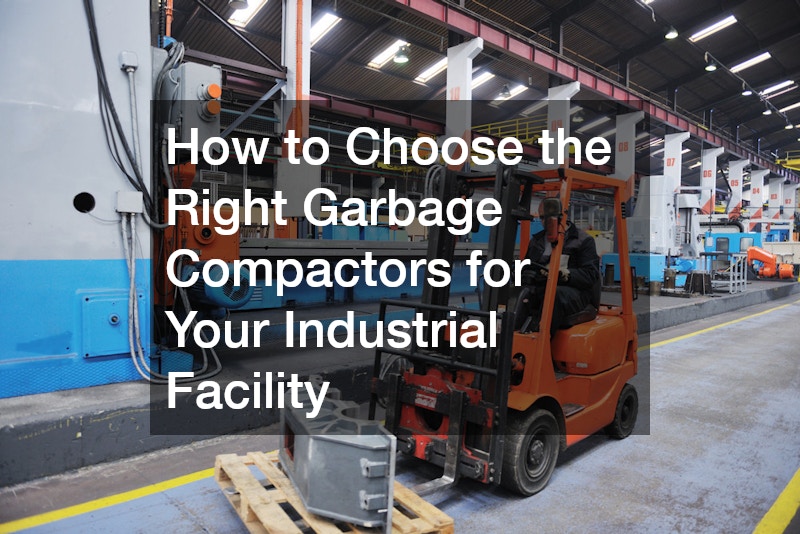Managing waste efficiently is a critical aspect of maintaining a clean and operational industrial facility. Choosing the right garbage compactors can significantly impact the overall waste management process. These machines not only save space but also reduce transportation costs and enhance the cleanliness of your site.
Making an informed choice requires understanding the needs of your facility, the types of waste generated, and the available compactor options. In this guide, we will explore essential factors to consider when selecting garbage compactors for your industrial facility.
Understanding Your Facility’s Waste Management Needs
Before purchasing a garbage compactor, it is crucial to understand the waste management needs specific to your facility. Not all facilities produce the same type of waste; hence, identifying the waste types is key to selecting an appropriate compactor. Common waste types in industrial facilities include cardboard, plastics, metals, and organic waste. Analyzing the waste stream composition will guide you in choosing a compactor that can best handle your waste. Failing to do so can lead to inefficient operation and higher management costs.
Understanding your waste generation volume is equally important as recognizing the types of waste produced. Facilities with higher volumes of waste generation may require more robust and larger capacity compactors. Conversely, facilities with smaller waste output might benefit from compactors with smaller capacities. Evaluating your current and projected waste generation will help ensure that you select a compactor capable of meeting your needs now and in the future. This foresight can prevent the need for costly replacements or additional equipment in the future.
Space consideration within your facility is another significant factor when choosing a garbage compactor. Facilities with limited space might prioritize compactors designed to fit in tight spaces. Conversely, facilities with ample space can opt for larger models that might offer higher efficiency. Regardless of space constraints, the right compactor should be accessible and able to integrate smoothly into the waste management workflow. Assessing your facility’s layout and spatial constraints is therefore essential in compactor selection.
Considering Types of Garbage Compactors
Garbage compactors come in a variety of types, each tailored to different applications and waste management needs. Stationary compactors are ideal for managing dry, solid waste and are commonly used in facilities with high waste production. These machines are mounted in a permanent location and can compact large volumes of waste efficiently. They are particularly beneficial for facilities with a constant waste output requiring frequent disposal. However, they may not be suitable for facilities generating liquid waste or those requiring mobility.
Another common type of compactor is the self-contained compactor, perfect for facilities that generate wet waste or mixed waste. These machines have both the compactor and the container integrated into one unit, preventing liquid waste from leaking. This makes them an excellent choice for facilities with organic waste components. Furthermore, self-contained compactors can handle a wide variety of waste types, offering greater flexibility and adaptability. Their mobility can also be an advantage when space constraints vary or change.
Reviewing Additional Factors
In addition to understanding waste types and volumes, other factors might influence your choice of garbage compactors. Energy efficiency is an increasingly important consideration, both for cost-saving and environmental reasons. Selecting a compactor with a high energy efficiency rating can significantly reduce operating costs. It also reinforces a commitment to environmentally friendly practices, which is becoming ever more important to regulatory bodies and consumers alike. Conducting a cost-benefit analysis to understand the potential savings from energy-efficient models versus traditional options is advisable.
Another aspect to consider is the maintenance and operational requirements of the compactor. Different models have varying levels of complexity and required upkeep, impacting the overall cost and efficiency. Choosing a model that aligns with your facility’s operational capabilities and maintenance staff availability is crucial to minimize downtime. Reliable support and maintenance services from manufacturers or suppliers are also vital considerations. Regular maintenance and prompt service can extend the lifespan of the equipment and maintain its operational efficiency.
The key to optimal waste management lies in matching the right technology with your specific needs. With a nuanced understanding and appropriate selection, garbage compactors become invaluable assets that streamline waste management processes and contribute positively to your facility’s overall efficiency and sustainability. As industries grow and waste management challenges increase, the right compactors will continue to play a pivotal role in meeting these challenges head-on. Embrace the opportunity to optimize your facility’s waste management strategy with carefully chosen garbage compactors.


